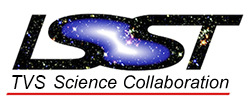TidalDisruptionEvents
Members
Members that collaborated to generate this roadmap:
- Iair Arcavi - UCSB / LCOGT
Primary subgroup contact:
- Iair Arcavi - UCSB / LCOGT
Subgroup MAF engineer:
- TBD
Subgroup Primary members
- Iair Arcavi - UCSB / LCOGT
- Niel Brandt - PSU
- Brad Cenko - NASA GSFC
- Geoffrey Clayton - Louisiana State University
- Suvi Gezari - University of Maryland
- James Guillochon - CfA
Subgroup Primary members
- Scott Anderson - U Washington
- Edo Berger - CfA
- Todd Boroson - LCOGT
- Ryan Chornock - Ohio University
- Wen-Fai Fong - Arizona
- Raffaella Margutti - CfA
- Arne Rau - MPE
- Rosanne Di Stefano - CfA
- Przemek Wozniak - LANL
Roadmap Outline
Introduction
TDE models are currently in flux. Very few events are well-observed, but new observations are going to change that in the coming few years. Our science goals and methods thus might change in the period leading up to LSST. TDEs are rare. LSST's strength is in large numbers allowing first statistical studies of SMBH masses and TDE populations and rates. van Velzen et al. (2011) estimate that LSST will find about 4000 TDEs per year.
Science Drivers
- Measuring black hole masses: This involves fitting models to TDE light curves. It is also relevant to correlate these measurements with host galaxy properties (mass, bulge/disk decomposition).
- Measuring the TDE rates as functions of black hole mass and galaxy types.
- Searching for optical signatures of high-energy TDEs: Co-observe with X-ray/UV telescopes? Recover sub-detection events from deep stacks?
- Testing GR (e.g. by early light curve deviations from non-GR models).
- Characterizing the TDE population.
Identifying TDEs
- In the center of its host (will require host-offset information).
- Constant blue (~few 10^4K) colors (easier to distinguish from SNe if get blue filters later rather than sooner).
- Slowly evolving (~month-long rise).
- Not showing past AGN-like variability (will require getting history at the position).
- Not in a known AGN host (will require x-ref with external catalogs).
- Preference if peaking around mag -20 (will require redshift information).
- Preference if in post-starburst (will require x-ref with southern/equatorial post-starburst catalog).
Open Questions
- What is the luminosity function for TDEs. This is necessary for testing:
- How cadence and colors affect SN/TDE/AGN discrimination?
- How cadence and colors affect black hole parameter modeling? Do we have to find TDEs on the rise for this?
- How cadence and colors affect rate calculations?
- Are there correlations between photometric and spectroscopic parameters? If so, we can get TDE spectral type statistics from light curves.
- Can we identify likely TDE hosts by their color?
- Will the brokers have SDSS-style photometric parametrizations of galaxies to x-ref with? Will they be able to x-ref spectroscopic redshifts and custom galaxy catalogs (e.g. post-starbursts)?
- Can we simulate the difficulties of recovering nuclear candidates in the MAF?
Road Map
Near Term (2016)
- Make a TDE light curve templates:
- Currently PS1-10jh has the best data. PS1-11af and PTF09ge are the only other two with pre-peak data.
- Use TDEFit to simulate TDE light curves with a grid of parameters.
- Make MAF metrics to test distinguishability from SNe and other relevant transients as a function of cadence and filters in collaboration with the supernova subgroup and the classification/characterization subgroup.
- Experiment with TDEFit to see which parameters are sensitive to post-peak vs. pre-peak data.
Intermediate Term (2017-2020)
- More sophisticated MAF runs that take into account image subtraction efficiency and transient identification in galaxy centers.
- More sophisticated MAF metrics that fold-in black hole parameter fitting.
- Get more data! As new observations come in and models are developed and constrained, improve the templates and repeat the above.
- Make a post-starburst galaxy catalog.
- When TDE host samples increase, test if host color is an effective discriminant.
- Make a list of requirements for brokers (desired x-refs).
- Archival studies of transient-survey data (PTF/Pan-STARRS) to estimate the number of candidates found according to different criteria.
LSST Commissioning Period
- …
LSST +1 Year
- Test broker interfaces.
LSST +3 Years
- …
LSST +10 Years
- …
Connections With Other Subgroups
- Supernovae - will also be looking for blue transients, and slow rising transients (for SLSNe)?
- Multi-Wavelength - will lead co-observing programs?
- AGN (separate science collaboration) - criteria for AGN flare to test in the MAF? Are there people in the AGN collaboration interested in TDEs?
